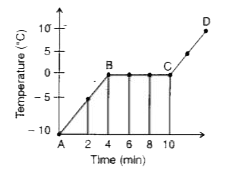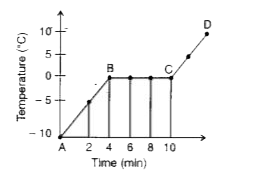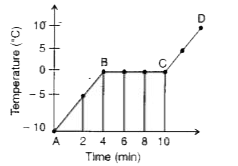Ravi kept some water for boiling for making tea. To mix sugar, he stirred it with a spoon. After some time, he observed that the temperature of the other end of the spoon had changed.
How did the temperature of the spoon change?
It became hot by the process of conduction.
It became cold by the process of conduction.
It became het hy the process of convection.
It became cold by the process of convection,
To understand how the temperature of the spoon changed when Ravi stirred the boiling water, we can break down the explanation into clear steps:
1. Understanding the Setup: Ravi placed a spoon in boiling water to stir it while making tea. One end of the spoon is in the hot water, while the other end is in his hand.
2. Temperature Difference: The end of the spoon that is in the boiling water has a higher temperature compared to the end that is in Ravi's hand. This creates a temperature gradient along the length of the spoon.
3. Heat Transfer Mechanism: The process by which heat moves from the hotter end of the spoon (in the boiling water) to the cooler end (in Ravi's hand) is called conduction.
4. Conduction Explained: In solids, heat is transferred through conduction, where the heat flows from the region of higher temperature to the region of lower temperature. The particles at the hot end of the spoon vibrate more vigorously and transfer their energy to the adjacent cooler particles.
5. Resulting Temperature Change: As a result of conduction, the temperature of the cooler end of the spoon (the part in Ravi's hand) increases. Therefore, after some time, Ravi notices that the temperature of the spoon has changed, and it feels warmer in his hand.
6. Conclusion: The temperature of the spoon changed due to the process of conduction, where heat from the boiling water was transferred along the spoon to the cooler end.
Topper's Solved these Questions
- HEATBOOK - BEIITIANSCHAPTER - HEATEXERCISE - HOTS Worksheet (Fill in the blanks)
3 Videos
- HEATBOOK - BEIITIANSCHAPTER - HEATEXERCISE - HOTS Worksheet (True or False)
4 Videos
- HEATBOOK - BEIITIANSCHAPTER - HEATEXERCISE - Conceptive Worksheet
15 Videos
- ELECTRIC CURRENT AND ITS EFFECTSBOOK - BEIITIANSCHAPTER - ELECTRIC CURRENT AND ITS EFFECTSEXERCISE - IIT JEE WORKSHEET (V. Matrix Matching)
3 Videos
- MEASUREMENTBOOK - BEIITIANSCHAPTER - MEASUREMENTEXERCISE - IIT JEE WORKSHEET (IV INTEGER TYPE)
1 Videos
Similar Questions
Vinod took a beaker of ice from a freezer and measured its temperature immediately. Then he measured the temperature of the ice in the beaker every 2 minutes. His results are shown in the graph. Vinod noticed during his experiment that the temperature of the ice did not change for a period of time.

What change did the ice undergo during this period of time?
View SolutionVinod took a beaker of ice from a freezer and measured its temperature immediately. Then he measured the temperature of the ice in the beaker every 2 minutes. His results are shown in the graph. Vinod noticed during his experiment that the temperature of the ice did not change for a period of time.

Which part of the graph corresponds to this period of time?
View Solution
Knowledge Check
When stirred with a spoon and left, water comes to rest after some time. It occurs due to
ASurface tensionBEnergy conservationCPressureDViscosityTwo bodies one hot an the other cold are kept in vacuum. What will happen to the temperature of the hot body after some time?
Aremain the sameBdecrease due to radiationCincrease due to radiationDincrease due to convectionA Veterinary doctor was examining a sick cat brought by a pet lover. When it was brought to the hospital, it was already dead. The pet lover wanted to find its time of death. He took the temperature of the cat at 11.30 pm which was 94.6∘F. He took the temperature again after one hour, the temperature was lower than the first observation. It was 93.4∘F. The room in which the cat was put is always at 70∘F. The normal temperature of the cat is taken as 98.6∘F when it was alive. The doctor estimated the time of death using Newton law of cooling which is governed by the differential equation: dTdt∝(T−70), where 70∘F is the room temperature and T is the temperature of the object at time t.
Substituting the two different observations of T and t made, in the solution of the differential equation dTdt=k(T-70) where k is a constant of proportion, time of death is calculated.
If the temperature was measured 2 hours after 11.30pm, will the time of death change? (Yes/No)ANo changeBDeath time increasedCDeath time decreasedDDeath time always constant
Ramu took four indentical iron balls of temperature 36∘C,10∘C,20∘C and 32∘C .He kept them in physical (thermal) contact with one another .After some time he measured the equilibrium temperautre attained by these four balls .What is the value of the equilibrium temperature?
View SolutionVinod took a beaker of ice from a freezer and measured its temperature immediately. Then he measured the temperature of the ice in the beaker every 2 minutes. His results are shown in the graph. Vinod noticed during his experiment that the temperature of the ice did not change for a period of time.

How long was this period of time?
View SolutionA current carrying conductor is connected with a cell, after some time temperature of conductor is increased by 1 unit. The percentage change in its resistivity is (Here α is temperature coefficient of resistivity)
View SolutionA milk vendor bought 28 litres of milk at the cost of Rs. 850 per litre. After adding some water, he sold the mixture at the same price. If he gains 12-5%, how much water did he add ?
View SolutionI made up a bed for him in a warm loose box next to the one where the other dogs slept. For two days I kept an eye on him, giving him no food but plenty of water. At the end of the second day he started to show some interest in his surroundings and on the third he began to whimper when he heard the dogs in the yard.
What change came in Tricki at the end of the second day?
View Solution
